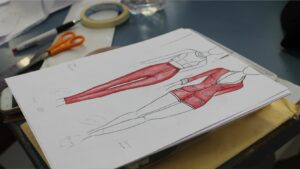In the ever-evolving landscape of fashion and textiles, digital visions have emerged as a driving force shaping the industry’s future. From virtual fashion shows to sustainable digital design solutions, technology is revolutionizing how we perceive and interact with clothing. Innovations like 3D modeling, augmented reality fitting rooms, and blockchain traceability are redefining the way garments are created, marketed, and consumed.
By embracing digital transformations, designers and brands can unlock a world of possibilities, pushing boundaries and challenging traditional norms. The fusion of technology and fashion not only enhances creativity but also paves the way for a more sustainable and inclusive industry.
Digital Visions for Fashion and Textiles
The Rise of 3D Printing in Fashion Design
 Fashion designers are increasingly turning to 3D printing technology to revolutionize the way garments are created. This innovative approach enables designers to experiment with intricate designs and materials that were previously unimaginable.
Fashion designers are increasingly turning to 3D printing technology to revolutionize the way garments are created. This innovative approach enables designers to experiment with intricate designs and materials that were previously unimaginable.
By utilizing 3D printing, designers can produce custom-made clothing pieces with precise measurements, leading to a more sustainable and efficient production process.
Virtual Reality and Augmented Reality in Shopping Experiences
Virtual reality (VR) and augmented reality (AR) are reshaping the shopping experience for consumers in the fashion and textiles industry. Through VR, customers can immerse themselves in virtual showrooms, try on digital clothing items, and customize their preferences before making a purchase. On the other hand, AR technology allows shoppers to visualize how garments will look on them without physically trying them on, enhancing convenience and reducing returns.
Sustainability and Innovation in Textiles
Eco-friendly Materials Through Digital Technology
 Digitization in the fashion and textiles industry has paved the way for the development of eco-friendly materials through innovative processes. By leveraging digital technologies, companies can now create textiles using sustainable materials such as organic cotton, recycled polyester, and biodegradable fabrics. These materials not only reduce the industry’s carbon footprint but also address the growing consumer demand for environmentally conscious products.
Digitization in the fashion and textiles industry has paved the way for the development of eco-friendly materials through innovative processes. By leveraging digital technologies, companies can now create textiles using sustainable materials such as organic cotton, recycled polyester, and biodegradable fabrics. These materials not only reduce the industry’s carbon footprint but also address the growing consumer demand for environmentally conscious products.
Designers and manufacturers are utilizing advanced technologies like 3D modeling and simulation to optimize the production of these eco-friendly materials. Through digital prototyping, they can experiment with various sustainable fibers and fabric blends to create durable yet environmentally friendly textiles.
Recycling Processes Enhanced by Digital Solutions
The integration of digital solutions has revolutionized recycling processes in the fashion and textiles sector, making it easier to repurpose materials and reduce waste. With the help of digital technologies such as artificial intelligence and machine learning, companies can now identify and sort different types of textiles for recycling more efficiently. This targeted approach enables them to separate components like fibers, dyes, and finishes, thereby improving the quality of recycled materials.
Moreover, blockchain technology plays a pivotal role in enhancing transparency and traceability throughout the recycling supply chain. By using blockchain-enabled platforms, businesses can track the entire lifecycle of recycled textiles, ensuring that each material undergoes the necessary processing stages. This level of visibility not only boosts consumer trust but also promotes a circular economy mindset within the industry.
The Impact of Artificial Intelligence
AI in Design and Manufacturing Processes
 In design and manufacturing, AI algorithms analyze data to forecast trends, optimize production schedules, and improve supply chain management. For instance, AI systems can analyze vast amounts of data to predict consumer preferences, helping designers create products that align with market demands. Moreover, AI-powered design tools can generate unique patterns, styles, and color combinations, accelerating the creative process and enabling designers to explore innovative concepts efficiently.
In design and manufacturing, AI algorithms analyze data to forecast trends, optimize production schedules, and improve supply chain management. For instance, AI systems can analyze vast amounts of data to predict consumer preferences, helping designers create products that align with market demands. Moreover, AI-powered design tools can generate unique patterns, styles, and color combinations, accelerating the creative process and enabling designers to explore innovative concepts efficiently.
AI also plays a crucial role in streamlining manufacturing processes. By leveraging AI-powered automation, fashion companies can enhance production efficiency, reduce costs, and minimize errors. AI algorithms can optimize inventory management, predict maintenance requirements for machinery, and improve quality control processes, ensuring consistent product quality and timely delivery to meet consumer expectations.
AI-Powered Consumer Insights and Personalization
AI-driven consumer insights enable brands to understand individual preferences, shopping behaviors, and trends, allowing for personalized marketing strategies and tailored product recommendations. Through machine learning algorithms, companies can analyze consumer data from various touchpoints to create targeted campaigns, improve customer engagement, and enhance loyalty.
Furthermore, AI facilitates personalized shopping experiences by offering virtual fitting rooms, personalized styling suggestions, and customized product recommendations based on individual preferences.



